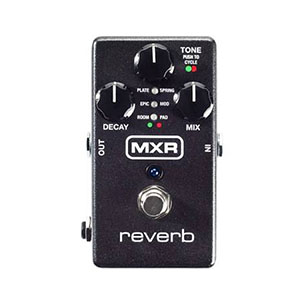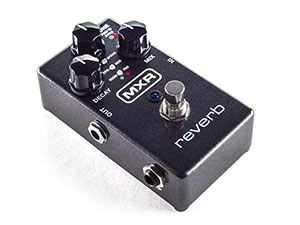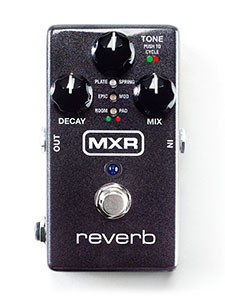- Home
- Instruments
- Gear
- Recording
- Lessons
- Reviews
- Blog


| Body And Neck: |  |
| Hardware: |  |
| Electronics: |  |
| Sound: |  |
| Value: |  |
It is often said that MXR no longer exists as a company. There is some truth to this statement. Although they are currently owned by Dunlop, this merger actually allowed MXR to breathe a breath of fresh air. Their quality spiked, but so did their designs. One of MXR's more outlandish pedals is the MXR M300. Built to compete with the latest digital models on the market, MXR M300 brings a very interesting set of features and advantages. It doesn't attack its competition head on, but rather uses indirect angles. We will clarify this in a moment. Put simply, this reverb is among the most capable pedals of this type available today.

MXR is known for super minimalist enclosure designs, which is also true for the M300. All black case with a simple MXR logo is all that's necessary. Actually, they are among the few companies who can pull off this type of design and make it attractive in a unique way. Even though this is a digital model, whatever mechanical components are present feature top tier quality. Some would say it's a nice improvement, especially if you're familiar with their foot switches.

In terms of controls, the top panel is very busy. You have three main control knobs, one of which acts as a dual purpose switch. We have Decay, Mix and Tone. If you push the Tone knob, you get to choose the reverb mode. Pull the knob and you are back to the standard control layout. It's a rather smart design. In terms of reverb modes, you have six to choose from. These are Plate, Spring, Epic, Mod, Room and Pad.
Here's the deal. MXR M300 was designed to go against TC Electronics HOF and similar pedals. Only problem is that it lacks the number of presets or even the ability to create your own. Plus, it costs more than those pedals. So how is it even competitive? The answer is simple. What it lacks in terms of flexibility, it compensates with great tone quality and signal retention. You can hook this bad boy at the very end of a long signal chain, and it won't kill the volume nor affect the integrity of said signal. The performance is simply superb. When every subtle detail element of your tone counts, this type of pedal is a must have tool.
The design and purpose of the MXR M300 was a fairly risky gamble to begin with. However, MXR pulled it off with the help of Dunlop's massive resources. They have managed to create a pedal that offers its own set of benefits to those who simply refuse to compromise. The price is a bit on the expensive side, however the type of quality this pedal brings to the table is something you either must have, or not. There is no middle ground. Many tried it, and it has proven to be the
choice of professionals.
For more info about the MXR M300 Reverb Guitar Effects Pedal, click here.
For more Reverb Pedals Currently On The Market, click here.

Reader Interactions